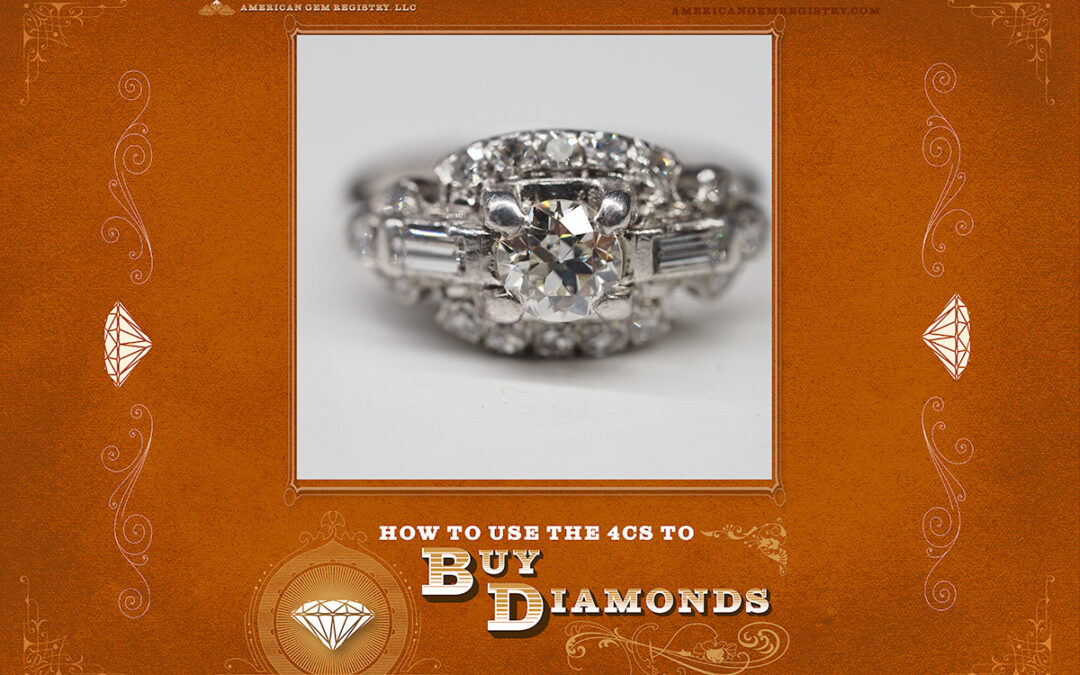In this insightful article, Neil Beaty, a gemologist and appraiser in Denver, Colorado, explores...

Call or Schedule an Appointment Online
Cut, Color, Clarity, and Carat Weight are known as the 4C’s of diamonds. They’re part of the GIA grading scale developed in the 30’s to standardize buying and selling of diamonds. You’ll find several articles here on this general topic including the definitions of what the 4C’s are and, equally importantly, what they are not. They’re mentioned throughout the various tutorials and here’s a general overview .
Don’t buy blind. The 4C’s help but they are not the end of the story. They’re the beginning.
Colorless diamonds, both natural and manmade, are graded using a system developed by the Gemological Institute of American in the 1930s. It’s been modified several times since, most recently in 2014, but the same general framework remains. It’s called the 4C’s, even though there are more than 4….
Color refers to the color—or lack of color— visible within a diamond, based on the GIA grading scale. The scale goes from D, the least amount of visible color, to Z, the most. D is the color of window glass. Z is the point that you stop asking “what’s that yellow tint in my diamond,” and start asking what’s that pretty yellow stone? There’s an additional grading scale beyond Z for Fancy Colors. Prices on stones generally go up as the grade gets closer to D.
From GIA:
Diamond color is all about what you can’t see. Diamonds are valued by how closely they approach colorlessness – the less color, the higher their value. (The exception to this is fancy color diamonds, such as pinks and blues, which lie outside this color range.) Most diamonds found in jewelry stores run from colorless to near-colorless, with slight hints of yellow or brown.
GIA’s color-grading scale for diamonds is the industry standard. The scale begins with the letter D, representing colorless, and continues with increasing presence of color to the letter Z, or light yellow or brown. Each letter grade has a clearly defined range of color appearance. Diamonds are color-graded by comparing them to stones of known color under controlled lighting and precise viewing conditions.
Many of these color distinctions are so subtle as to be invisible to the untrained eye. But these slight differences make a very big difference in diamond quality and price.
‘Clarity’ is determined by the visibility of microscopic inclusions and imperfections within a diamond. Diamonds with few to no inclusions are generally more expensive than stones where the presence of inclusions affects the beauty or durability of the stone.
From GIA:
The GIA Clarity Scale contains 11 grades, with most diamonds falling into the VS (very slightly included) or SI (slightly included) categories. In determining a clarity grade, the GIA system considers the size, nature, position, color or relief, and quantity of clarity characteristics visible under 10× magnification.
Carat is the unit of measurement used to describe the weight of a diamond. It’s one way of measuring size. A carat is 200 milligrams or ⅕ of a gram. In general, the price of a diamond goes up in proportion to the weight.
Cut refers to the facets, symmetry, polish and reflective qualities of a diamond. It’s the part of a diamond’s grade that’s affected by man. Until recently, 2006, GIA didn’t have a scale for cut grade at all. What they chose is a bit complicated and, unlike the above, you can’t really tell the cut grade by looking, even under magnification. It requires some fairly exotic tools.
Cut is where the most deviation happens between the various labs. IGI, another major lab, uses many of the same words but a very different scale. AGS doesn’t even use the same words.
From GIA:
The GIA Cut Grading System applies to the most popular cutting style – the standard round brilliant – and all clarities across the D-to-Z color range. There are five cut grades: Excellent (EX), Very Good (VG), Good (G), Fair (F) and Poor (P).
A diamond with an Excellent cut grade is very bright. It shows an even pattern with good contrast between light and dark areas, so the reflections appear crisp and well-balanced. This tells you that the cutter made the best possible use of the rough.
The Good cut grade diamond isn’t quite as bright – reflections aren’t as sharp and there’s more darkness or dullness in the diamond.
The Poor cut grade diamond has much more prominent dark areas or dullness. Given the choice, most people would pick either of the first two diamonds instead of this stone.
Yes, there are more than 4. Diamond grading is a rabbit hole for shoppers and it’s easy to get lost. They are a blind item and the more you look the more you find to learn. Cut, in particular, is a tricky topic to navigate but Country of Origin, and Certification are big topics as well.
This scale only applies to natural diamonds. Lab grown diamonds have different sorts of inclusions as well as some different attributes, like method of manufacture.

In this insightful article, Neil Beaty, a gemologist and appraiser in Denver, Colorado, explores...

Nearly everyone who is shopping for a diamond is familiar with the 4C’s: clarity, color, cut, and...
In this insightful article, Neil Beaty, a gemologist and appraiser in Denver, Colorado, explores...
Nearly everyone who is shopping for a diamond is familiar with the 4C’s: clarity, color, cut, and...
Do you need an item appraised by a professional? Schedule an appointment today with Denver's most trusted AGS Independent Certified Gemologist Appraiser.